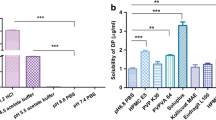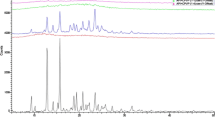Abstract
Purpose
The aim of this research was to study the interplay of solid and solution state phase transformations during the dissolution of ritonavir (RTV) amorphous solid dispersions (ASDs).
Methods
RTV ASDs with polyvinylpyrrolidone (PVP), polyvinylpyrrolidone vinyl acetate (PVPVA) and hydroxypropyl methylcellulose acetate succinate (HPMCAS) were prepared at 10–50% drug loading by solvent evaporation. The miscibility of RTV ASDs was studied before and after exposure to 97% relative humidity (RH). Non-sink dissolution studies were performed on fresh and moisture-exposed ASDs. RTV and polymer release were monitored using ultraviolet-visible spectroscopy. Techniques including fluorescence spectroscopy, confocal imaging, scanning electron microscopy (SEM), atomic force microscopy (AFM), differential scanning calorimetry (DSC) and nanoparticle tracking analysis (NTA) were utilized to monitor solid and the solution state phase transformations.
Results
All RTV-PVP and RTV-PVPVA ASDs underwent moisture-induced amorphous-amorphous phase separation (AAPS) on high RH storage whereas RTV-HPMCAS ASDs remained miscible. Non-sink dissolution of PVP- and PVPVA-based ASDs at low drug loadings led to rapid RTV and polymer release resulting in concentrations in excess of amorphous solubility, liquid-liquid phase separation (LLPS) and amorphous nanodroplet formation. High drug loading PVP- and PVPVA-based ASDs did not exhibit LLPS upon dissolution as a consequence of extensive AAPS in the hydrated ASD matrix. All RTV-HPMCAS ASDs led to LLPS upon dissolution.
Conclusions
RTV ASD dissolution is governed by a competition between the dissolution rate and the rate of phase separation in the hydrated ASD matrix. LLPS was observed for ASDs where the drug release was polymer controlled and only ASDs that remained miscible during the initial phase of dissolution led to LLPS. Techniques such as fluorescence spectroscopy, confocal imaging and SEM were useful in understanding the phase behavior of ASDs upon hydration and dissolution and were helpful in elucidating the mechanism of generation of amorphous nanodroplets.











Similar content being viewed by others
Abbreviations
- ASD:
-
Amorphous solid dispersion
- AAPS:
-
Amorphous-amorphous phase separation
- AFM:
-
Atomic force microscopy
- DSC:
-
Differential scanning calorimetry
- DL:
-
Drug loading
- HPMCAS:
-
Hydroxypropyl methylcellulose acetate succinate
- LLPS:
-
Liquid-liquid phase separation
- NTA:
-
Nanotracking analysis
- PVP:
-
Polyvinylpyrrolidone
- PVPVA:
-
Polyvinylpyrrolidone vinyl acetate
- RH:
-
Relative humidity
- RTV:
-
Ritonavir
- UV-Vis:
-
Ultraviolet-visible
References
Di L, Fish PV, Mano T. Bridging solubility between drug discovery and development. Drug Discov Today. 2012;17(9):486–95.
Lipinski CA. Poor aqueous solubility-an industry wide problem in ADME screening. Am Pharm Rev. 2002;5:82–5.
Hancock BC, Zografi G. Characteristics and significance of the amorphous state in pharmaceutical systems. J Pharm Sci. 1997;86(1):1–12.
Murdande SB, Pikal MJ, Shanker RM, Bogner RH. Solubility advantage of amorphous pharmaceuticals: I. A thermodynamic analysis. J Pharm Sci. 2010;99(3):1254–64.
Vasconcelos T, Sarmento B, Costa P. Solid dispersions as strategy to improve oral bioavailability of poor water soluble drugs. Drug Discov Today. 2007;12(23–24):1068–75.
Rumondor AC, Marsac PJ, Stanford LA, Taylor LS. Phase behavior of poly (vinylpyrrolidone) containing amorphous solid dispersions in the presence of moisture. Mol Pharm. 2009;6(5):1492–505.
Rumondor AC, Wikström H, Van Eerdenbrugh B, Taylor LS. Understanding the tendency of amorphous solid dispersions to undergo amorphous–amorphous phase separation in the presence of absorbed moisture. AAPS PharmSciTech. 2011;12(4):1209–19.
Rumondor AC, Stanford LA, Taylor LS. Effects of polymer type and storage relative humidity on the kinetics of felodipine crystallization from amorphous solid dispersions. Pharm Res. 2009;26(12):2599–606.
Ilevbare GA, Taylor LS. Liquid–liquid phase separation in highly supersaturated aqueous solutions of poorly water-soluble drugs: implications for solubility enhancing formulations. Cryst Growth Des. 2013;13(4):1497–509.
Raina SA, Zhang GG, Alonzo DE, Wu J, Zhu D, Catron ND, et al. Enhancements and limits in drug membrane transport using supersaturated solutions of poorly water soluble drugs. J Pharm Sci. 2014;103(9):2736–48.
Konno H, Handa T, Alonzo DE, Taylor LS. Effect of polymer type on the dissolution profile of amorphous solid dispersions containing felodipine. Eur J Pharm Biopharm. 2008;70(2):493–9.
Alonzo DE, Gao Y, Zhou D, Mo H, Zhang GG, Taylor LS. Dissolution and precipitation behavior of amorphous solid dispersions. J Pharm Sci. 2011;100(8):3316–31.
Alonzo DE, Zhang GG, Zhou D, Gao Y, Taylor LS. Understanding the behavior of amorphous pharmaceutical systems during dissolution. Pharm Res. 2010;27(4):608–18.
Purohit HS, Taylor LS. Phase separation kinetics in amorphous solid dispersions upon exposure to water. Mol Pharm. 2015;12(5):1623–35.
Van Eerdenbrugh B, Alonzo DE, Taylor LS. Influence of particle size on the ultraviolet spectrum of particulate-containing solutions: implications for in-situ concentration monitoring using UV/Vis fiber-optic probes. Pharm Res. 2011;28(7):1643–52.
Dubois M, Gilles KA, Hamilton JK, Rebers P, Smith F. Colorimetric method for determination of sugars and related substances. Anal Chem. 1956;28(3):350–6.
Levy G, Fergus D. Microdetermination of polyvinylpyrrolidone in aqueous solution and in body fluids. Anal Chem. 1953;25(9):1408–10.
Raina SA, Alonzo DE, Zhang GG, Gao Y, Taylor LS. Using environment-sensitive fluorescent probes to characterize liquid-liquid phase separation in supersaturated solutions of poorly water soluble compounds. Pharm Res. 2015;32(11):3660–73.
Kalyanasundaram K, Thomas J. Environmental effects on vibronic band intensities in pyrene monomer fluorescence and their application in studies of micellar systems. J Am Chem Soc. 1977;99(7):2039–44.
Kalyanasundaram K, Thomas JK. Solvent-dependent fluorescence of pyrene-3-carboxaldehyde and its applications in the estimation of polarity at micelle-water interfaces. J Phys Chem. 1977;81(23):2176–80.
Purohit HS, Taylor LS. Miscibility of itraconazole–hydroxypropyl methylcellulose blends: insights with high resolution analytical methodologies. Mol Pharm. 2015;12(12):4542–53.
Greenspan P, Fowler SD. Spectrofluorometric studies of the lipid probe, nile red. J Lipid Res. 1985;26(7):781–9.
Sackett DL, Wolff J. Nile red as a polarity-sensitive fluorescent probe of hydrophobic protein surfaces. Anal Biochem. 1987;167(2):228–34.
Lauer ME, Siam M, Tardio J, Page S, Kindt JH, Grassmann O. Rapid assessment of homogeneity and stability of amorphous solid dispersions by atomic force microscopy—from bench to batch. Pharm Res. 2013;30(8):2010–22.
Qi S, Moffat JG, Yang Z. Early stage phase separation in pharmaceutical solid dispersion thin films under high humidity: improved spatial understanding using probe-based thermal and spectroscopic nanocharacterization methods. Mol Pharm. 2013;10(3):918–30.
Andronis V, Yoshioka M, Zografi G. Effects of sorbed water on the crystallization of indomethacin from the amorphous state. J Pharm Sci. 1997;86(3):346–51.
Shamblin SL, Zografi G. The effects of absorbed water on the properties of amorphous mixtures containing sucrose. Pharm Res. 1999;16(7):1119–24.
Marsac PJ, Rumondor AC, Nivens DE, Kestur US, Stanciu L, Taylor LS. Effect of temperature and moisture on the miscibility of amorphous dispersions of felodipine and poly (vinyl pyrrolidone). J Pharm Sci. 2010;99(1):169–85.
Harmon P, Galipeau K, Xu W, Brown C, Wuelfing WP. Mechanism of dissolution-induced nanoparticle formation from a copovidone-based amorphous solid dispersion. Mol Pharm. 2016;13(5):1467–81.
Zhang J, Zografi G. Water vapor absorption into amorphous sucrose-poly (vinyl pyrrolidone) and trehalose–poly (vinyl pyrrolidone) mixtures. J Pharm Sci. 2001;90(9):1375–85.
Robard A, Patterson D, Delmas G. The "Δχ effect" and polystyrene-poly (vinyl methyl ether) compatibility in solution. Macromolecules. 1977;10(3):706–8.
Rumondor AC, Stanford LA, Taylor LS. Effects of polymer type and storage relative humidity on the kinetics of felodipine crystallization from amorphous solid dispersions. Pharm Res. 2009;26(12):2599.
Rumondor AC, Taylor LS. Effect of polymer hygroscopicity on the phase behavior of amorphous solid dispersions in the presence of moisture. Mol Pharm. 2010;7(2):477–90.
Taylor LS, Zhang GG. Physical chemistry of supersaturated solutions and implications for oral absorption. Adv Drug Deliv Rev. 2016;101:122–42.
Indulkar AS, Gao Y, Raina SA, Zhang GG, Taylor LS. Exploiting the phenomenon of liquid–liquid phase separation for enhanced and sustained membrane transport of a poorly water-soluble drug. Mol Pharm. 2016;13(6):2059–69.
Simonelli A, Mehta S, Higuchi W. Dissolution rates of high energy polyvinylpyrrolidone (PVP)-sulfathiazole coprecipitates. J Pharm Sci. 1969;58(5):538–49.
Simonelli A, Mehta S, Higuchi W. Dissolution rates of high energy sulfathiazole-povidone coprecipitates II: characterization of form of drug controlling its dissolution rate via solubility studies. J Pharm Sci. 1976;65(3):355–61.
Chen Y, Wang S, Wang S, Liu C, Su C, Hageman M, et al. Initial drug dissolution from amorphous solid dispersions controlled by polymer dissolution and drug-polymer interaction. Pharm Res. 2016;33(10):2445–58.
Corrigan OI. Mechanisms of dissolution of fast release solid dispersions. Drug Dev Ind Pharm. 1985;11(2–3):697–724.
Tachibana T, Nakamura A. A methode for preparing an aqueous colloidal dispersion of organic materials by using water-soluble polymers: dispersion of Β-carotene by polyvinylpyrrolidone. Colloid Polym Sci. 1965;203(2):130–3.
Jackson MJ, Kestur US, Hussain MA, Taylor LS. Dissolution of danazol amorphous solid dispersions: supersaturation and phase behavior as a function of drug loading and polymer type. Mol Pharm. 2015;13(1):223–31.
Noyes AA, Whitney WR. The rate of solution of solid substances in their own solutions. J Am Chem Soc. 1897;19(12):930–4.
ACKNOWLEDGMENTS AND DISCLOSURES
Financial support to HSP from Migliaccio/Pfizer graduate fellowship is greatly acknowledged. The authors would also like to thank the National Science Foundation through grant number EEC-0540855, and the National Institutes of Health through grant number R42 GM100657–03, for financial support.
Author information
Authors and Affiliations
Corresponding author
Electronic supplementary material
ESM 1
(DOCX 1009 kb)
Rights and permissions
About this article
Cite this article
Purohit, H.S., Taylor, L.S. Phase Behavior of Ritonavir Amorphous Solid Dispersions during Hydration and Dissolution. Pharm Res 34, 2842–2861 (2017). https://doi.org/10.1007/s11095-017-2265-5
Received:
Accepted:
Published:
Issue Date:
DOI: https://doi.org/10.1007/s11095-017-2265-5




